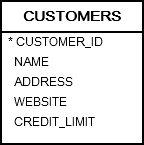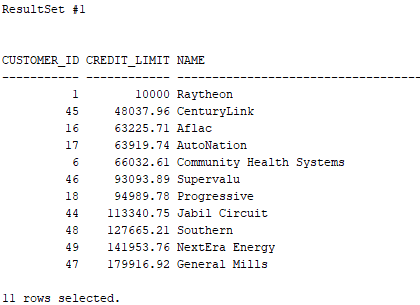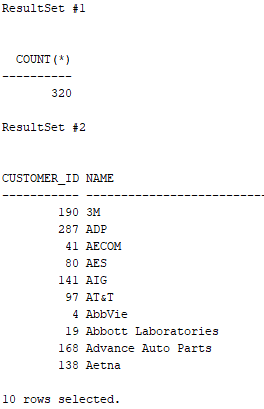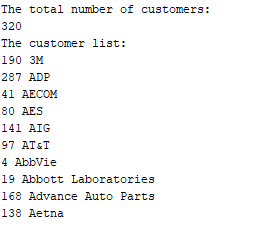Summary: in this tutorial, you will learn how to return one or more result sets from a stored procedure using implicit statement results.
Prior to Oracle Database 12c, you can return a result set from a stored procedure using the OUT REF CURSOR parameters.
To make the migration of other databases to the Oracle Database easier, Oracle Database 12c Release 1 added a new feature called implicit statement result that allows you to return one or more result sets from a stored procedure by using the dbms_sql package.
We’ll use the customers table from the sample database for the following examples:

Returning a single result set
The following statement creates a stored procedure that returns customers who have credit limits are greater than a specific credit:
CREATE OR REPLACE PROCEDURE get_customer_by_credit(
min_credit NUMBER
)
AS
c_customers SYS_REFCURSOR;
BEGIN
-- open the cursor
OPEN c_customers FOR
SELECT customer_id, credit_limit, name
FROM customers
WHERE credit_limit > min_credit
ORDER BY credit_limit;
-- return the result set
dbms_sql.return_result(c_customers);
END;
Code language: PostgreSQL SQL dialect and PL/pgSQL (pgsql)In this stored procedure:
- First, declare a cursor with type
SYS_REFCURSORin the declaration section. - Second, open the cursor associated with a query.
- Third, use the
dbms_sql.return_result()function which accepts a cursor as an argument and returns the result set.
To test the stored procedure, you can execute it as follows:
EXEC get_customer_by_credit(5000);
Code language: PostgreSQL SQL dialect and PL/pgSQL (pgsql)Here is the output:

Returning multiple result sets
The following statement creates a stored procedure that returns the customer result set by pages specified by page no and page size. On top of that, it returns the total rows of the customers table.
CREATE OR REPLACE PROCEDURE get_customers(
page_no NUMBER,
page_size NUMBER
)
AS
c_customers SYS_REFCURSOR;
c_total_row SYS_REFCURSOR;
BEGIN
-- return the total of customers
OPEN c_total_row FOR
SELECT COUNT(*)
FROM customers;
dbms_sql.return_result(c_total_row);
-- return the customers
OPEN c_customers FOR
SELECT customer_id, name
FROM customers
ORDER BY name
OFFSET page_size * (page_no - 1) ROWS
FETCH NEXT page_size ROWS ONLY;
dbms_sql.return_result(c_customers);
END;
Code language: PostgreSQL SQL dialect and PL/pgSQL (pgsql)The following statement calls the get_customers() procedure:
EXEC get_customers(1,10)
Code language: PostgreSQL SQL dialect and PL/pgSQL (pgsql)
It returned two result sets. The first result set is the total rows of the customers table. The second one is the first 10 customers on page 1.
Using the get_next_result() procedure
Typically, you process result sets returned by a procedure using client programming languages such as Python, C#, and Java.
However, if you want to process result sets using PL/SQL, you can use the get_next_resultset() procedure in the DBMS_SQL package.
The following anonymous block calls the get_customers() procedure and uses the get_next_resultset() procedure to process the result sets.
Since the get_customers() returns multiple result sets, we handle the result sets based on their number of columns.
SET SERVEROUTPUT ON
DECLARE
l_sql_cursor PLS_INTEGER;
c_cursor SYS_REFCURSOR;
l_return PLS_INTEGER;
l_column_count PLS_INTEGER;
l_desc_tab dbms_sql.desc_tab;
l_total_rows NUMBER;
l_customer_id customers.customer_id%TYPE;
l_name customers.NAME%TYPE;
BEGIN
-- Execute the function.
l_sql_cursor := dbms_sql.open_cursor(treat_as_client_for_results => TRUE);
dbms_sql.parse(C => l_sql_cursor,
STATEMENT => 'BEGIN get_customers(1,10); END;',
language_flag => dbms_sql.NATIVE);
l_return := dbms_sql.EXECUTE(l_sql_cursor);
-- Loop over the result sets.
LOOP
-- Get the next resultset.
BEGIN
dbms_sql.get_next_result(l_sql_cursor, c_cursor);
EXCEPTION
WHEN no_data_found THEN
EXIT;
END;
-- Get the number of columns in each result set.
l_return := dbms_sql.to_cursor_number(c_cursor);
dbms_sql.describe_columns (l_return, l_column_count, l_desc_tab);
c_cursor := dbms_sql.to_refcursor(l_return);
-- Handle the result set based on the number of columns.
CASE l_column_count
WHEN 1 THEN
dbms_output.put_line('The total number of customers:');
FETCH c_cursor
INTO l_total_rows;
dbms_output.put_line(l_total_rows);
CLOSE c_cursor;
WHEN 2 THEN
dbms_output.put_line('The customer list:');
LOOP
FETCH c_cursor
INTO l_customer_id, l_name;
EXIT WHEN c_cursor%notfound;
dbms_output.put_line(l_customer_id || ' ' || l_name);
END LOOP;
CLOSE c_cursor;
ELSE
dbms_output.put_line('An error occurred!');
END CASE;
END LOOP;
END;
/
Code language: PostgreSQL SQL dialect and PL/pgSQL (pgsql)The following shows the output:

In this tutorial, you have learned how to return one or more result sets from a stored procedure.